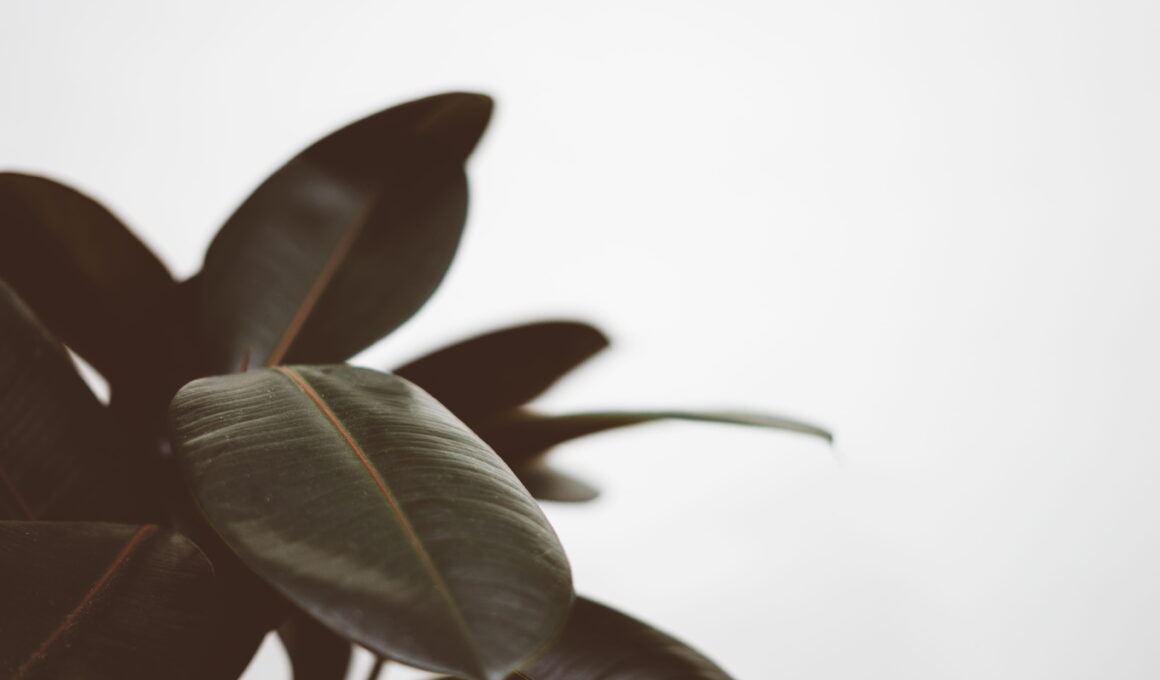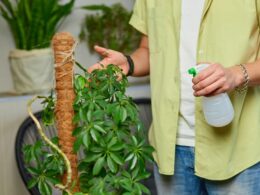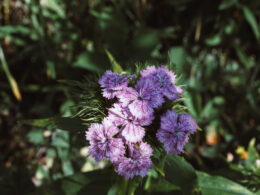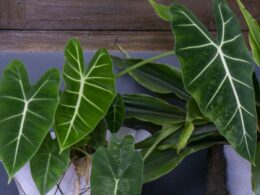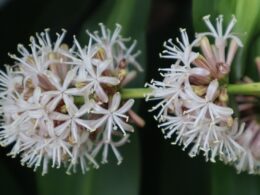What Is a Rubber Plant? Names, Origin, and Characteristics
Before we share our rubber plant care tips, let’s introduce the species. The rubber plant (Ficus elastica) is a tree that is native to tropical regions of Asia and Africa, but it can now be found in warm climates all over the world. Some common names for Ficus elastica are:
- rubber fig;
- (Indian) rubber bush;
- (Indian) rubber tree.
The rubber plant is a large, evergreen tree that can grow up to 130 feet tall. It has glossy, dark green leaves that are smooth and leathery to the touch. The tree produces small, white flowers that bloom in clusters.
It’s often grown as an ornamental tree, and its latex was historically used in the production of rubber. Currently, a different species – the Pará rubber tree – is the main source of latex.
Rubber Plant Varieties – Burgundy Rubber Tree Plant and More
While rubber plants can come in many colors and leaf shapes, there are three main varieties that are commonly grown as houseplants:
- burgundy rubber plant (Ficus elastica ‘Burgundy’) – this variety has dark purple leaves with red veins.
- Abidjan rubber plant (Ficus elastica ‘Abidjan’) – this variety has dark green leaves with yellow veins.
- variegated rubber plant (Ficus elastica ‘Variegata’) – this variety has green leaves with white or cream-colored markings.
Rubber Plant Care – Soil and Fertilization Needs
The rubber plant prefers a well-drained, sandy soil – the pot should have adequate drainage holes. It’s important to not overwater the plant, as this can lead to root rot. Rubber trees should be fertilized every two weeks during the growing season, and every month during the winter. A general-purpose fertilizer will work well. The fertilizer should be diluted to half-strength before being applied, or it may burn the foliage.
Rubber Plant Care – Watering Needs
Watering is a key part of rubber plant care. This plant prefers to be kept evenly moist, but not soggy. Allow the top inch or so of soil to dry slightly to the touch before watering again. During the winter months, when the plant is dormant, you can reduce watering to once every two weeks or so.
Rubber Plant Care – Light Needs
One of the reasons why rubber plant care is easy is that these plants can grow in a wide range of light conditions. They prefer bright, indirect light, but they can also tolerate low light levels. Avoid direct sunlight, though.
Rubber Plant Care – Temperature and Humidity Needs
Rubber plants are native to tropical regions and generally prefer warm, humid conditions. They’ll tolerate a wide range of temperatures, but they prefer them to be 60-65 °F at night and 75-80 °F during the day. Avoid subjecting your rubber tree to sudden temperature drops or cold drafts.
Additionally, rubber plants need high levels of humidity to thrive. If the air in your home is too dry, you can increase the humidity around your rubber plant by placing it on a pebble tray or misting it with water regularly.
When and How to Prune Rubber Plants?
Pruning is an important part of rubber plant care indoors. It helps to encourage new growth, and can also be used to control the size and shape of the plant. The best time to prune rubber plants is in the spring, before new growth begins.
To prune your rubber tree, start by removing any dead or damaged leaves or stems. Then, cut back the remaining leaves and stems to the desired length. You can also shape the plant by trimming it into a cone or ball shape. Use sharp, sterile pruning shears to avoid damaging the plant.
How to Propagate Rubber Plants?
Rubber trees are easy to propagate from cuttings. Here are the instructions.
- Protect the work surface from sap that will ooze from cut stems.
- Take a 6-inch cutting with at least 4 leaf nodes from the tip of a leggy rubber tree branch.
- Remove the bottom leaves, so that only one leaf remains at the top.
- Fill a small pot with a soilless potting mix and perlite. Moisten it thoroughly.
- Apply a rooting hormone to the end of the cutting and plant it in the pot.
Be careful when handling the cutting, as latex can be very messy. Once the cutting has rooted, it can be transplanted into a larger pot or outdoors. With a little patience, you can easily propagate your own rubber tree.
How Often Should You Repot Rubber Plants?
Repot your rubber tree every two to three years to give it fresh potting mix and a new home. You can also use this opportunity to prune the roots and top of the plant to control its size.
When repotting, choose a pot that is only slightly larger than the current one. This will help to control the plant’s size. Be sure to use a well-draining potting soil, as rubber trees are susceptible to root rot. It’s best to repot rubber plants in the spring, before new growth begins.
Common Problems with Rubber Plants
Plant diseases are uncommon in indoor plants, but your rubber plant might be susceptible to mealybugs, scale, or spider mites. These pests can be controlled with a damp cloth with a bit of alcohol.
If the leaves are yellowing or dropping off, it could be a sign of too much or too little water. Leaf loss can also be caused by a lack of light or cold drafts. Another issue is root rot, which is usually caused by a soil mix that doesn’t drain well or too much watering.
Ready to Care for a Rubber Plant?
To sum it up, rubber plant care isn’t too difficult. These plants are relatively low-maintenance, and can thrive in a wide range of conditions. Just be sure to give your rubber tree enough space to grow, plenty of bright light, and the occasional misting (or pebble tray) to keep the humidity high.





